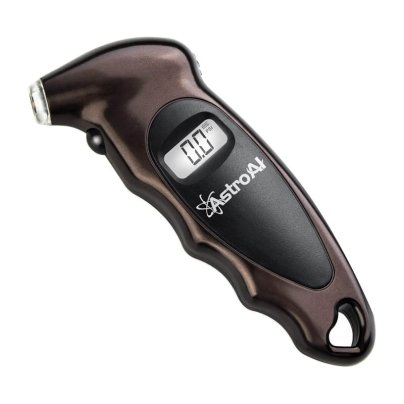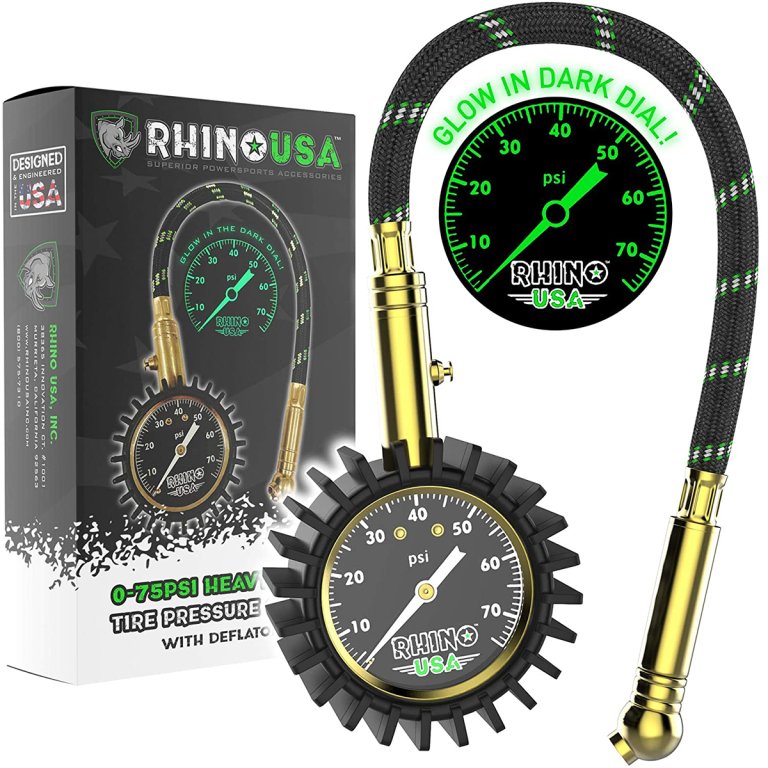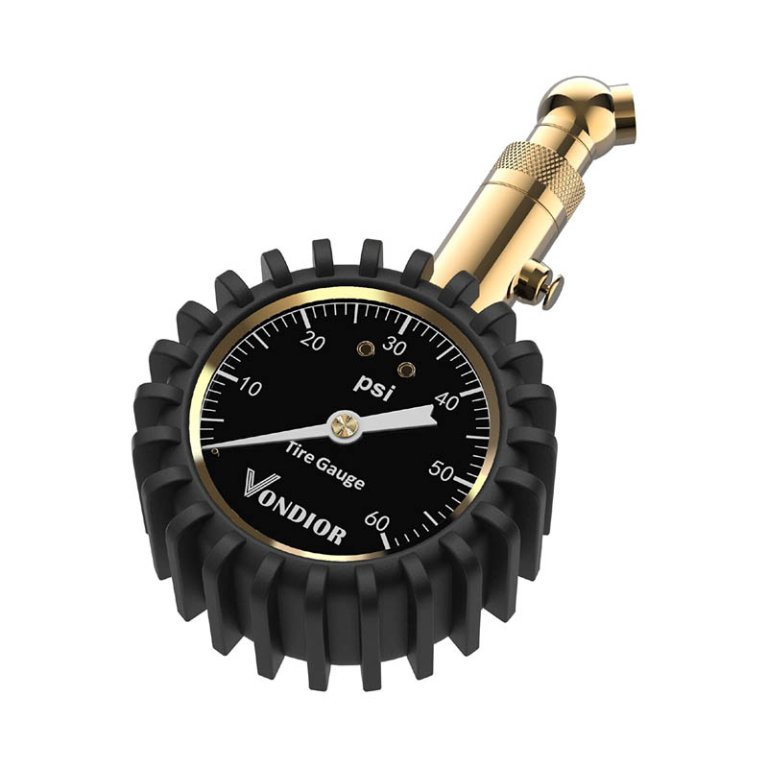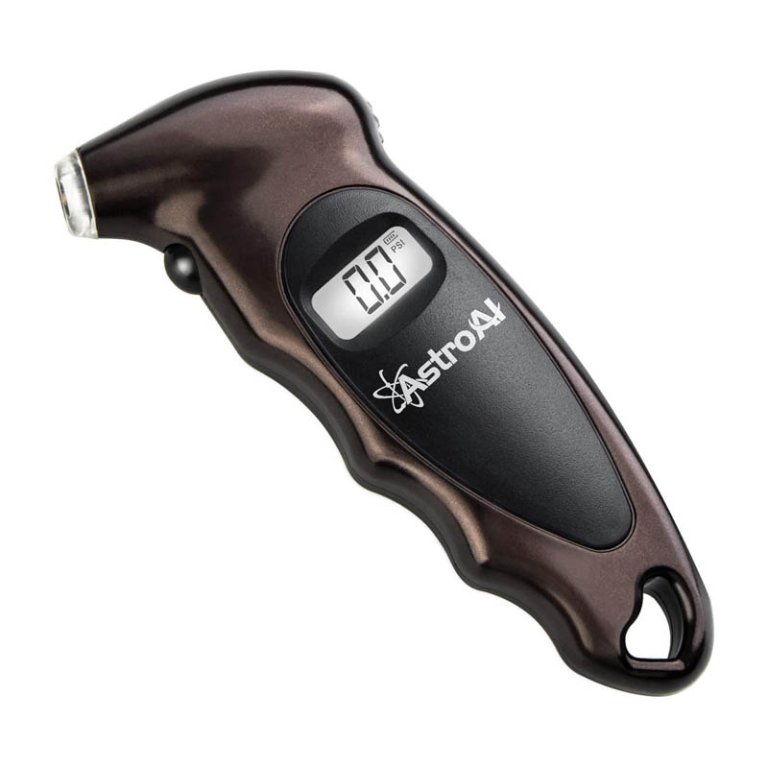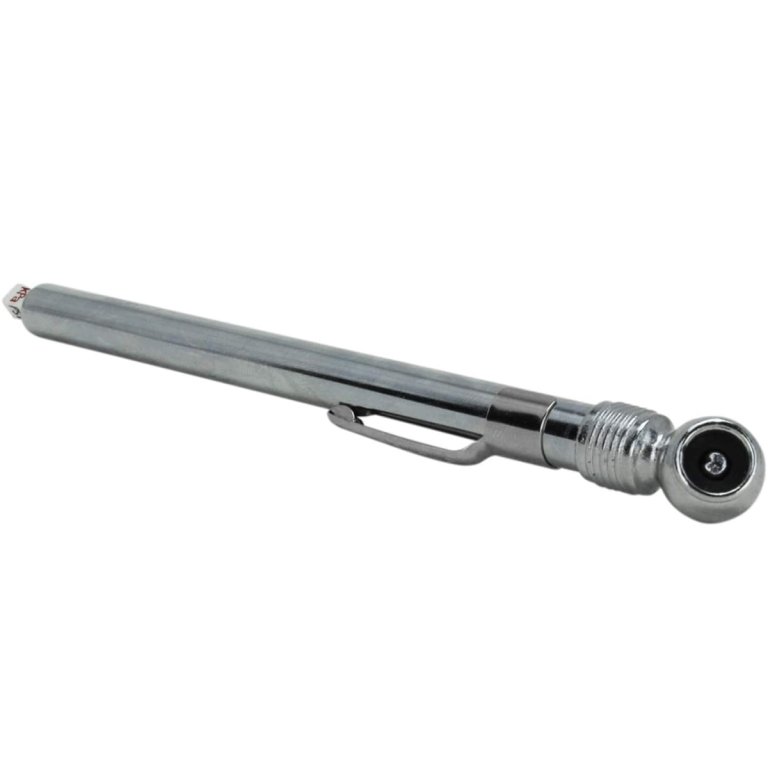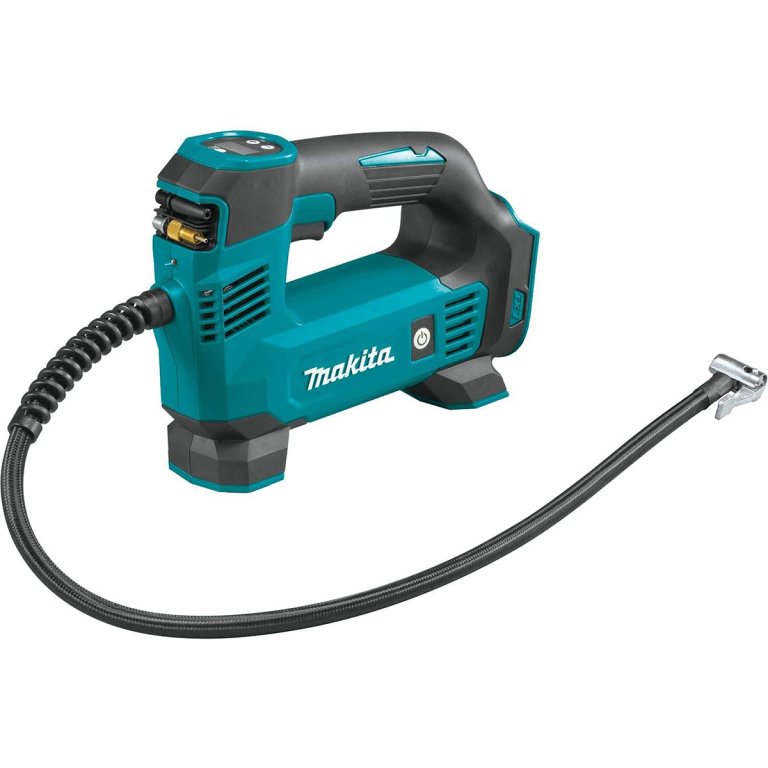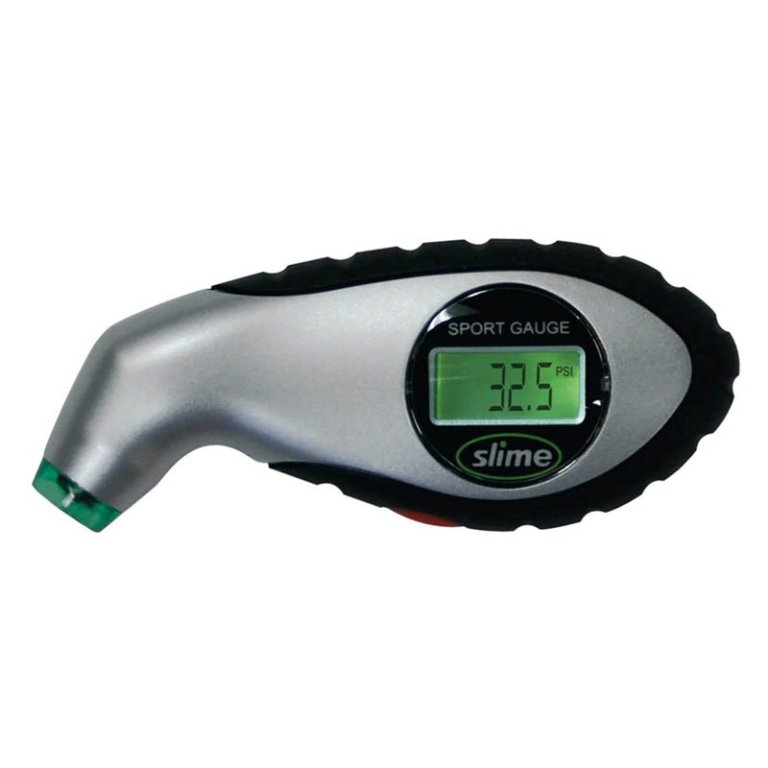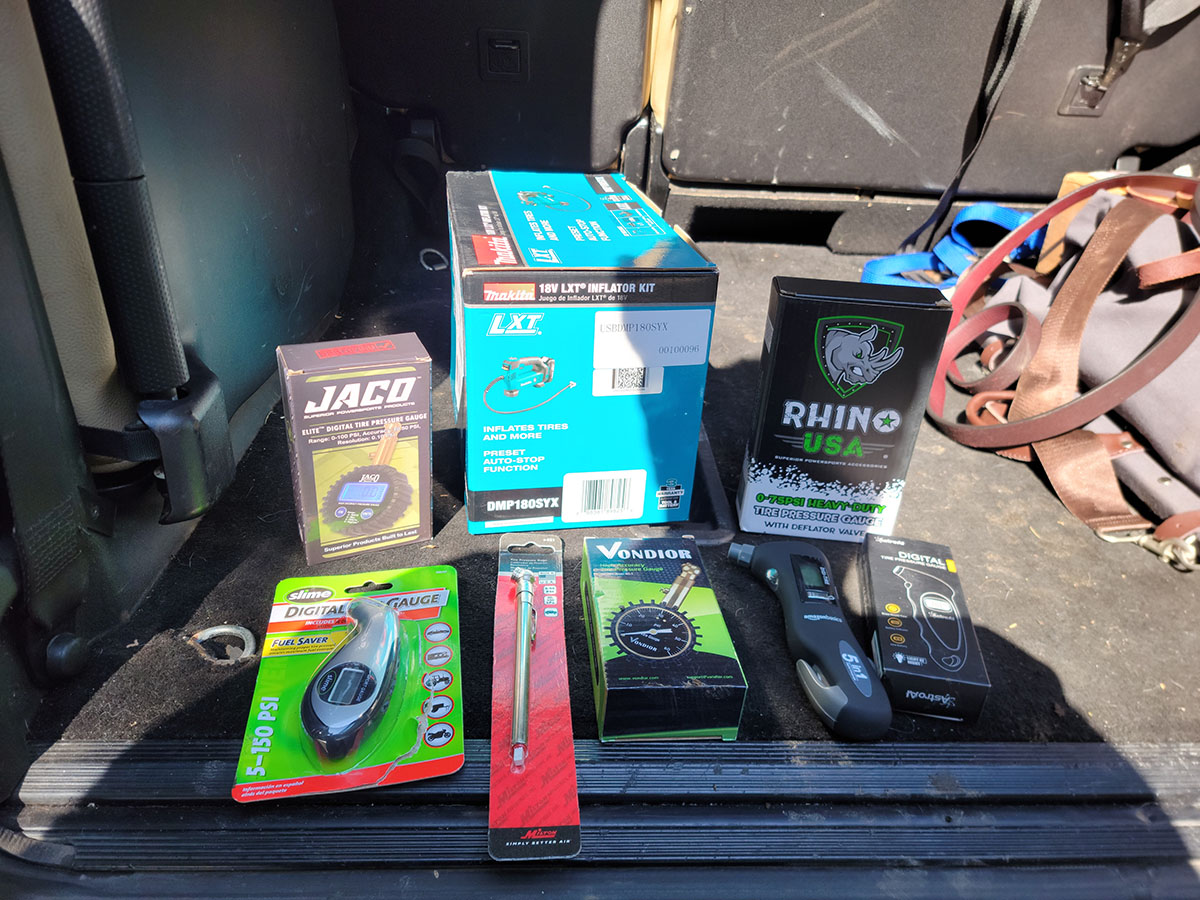
We may earn revenue from the products available on this page and participate in affiliate programs. Learn More ›
As Taylor Swift sang, “The devil’s in the details.” You might not think a simple thing like tire pressure is crucial to your vehicle’s operation, but it is. The only way to truly track that pressure is with the best tire pressure gauge.
Maintaining the correct air pressure across all tires enables even distribution of weight. Doing this gives you the most stability and ensures uniform tire degradation. With one or more tires unevenly worn, underinflated, or overinflated, there can be a significant decrease in performance when attempting to corner, stop, or evade an accident. The importance of a tire pressure gauge speaks for itself.
To help you choose the best tire pressure gauge, we performed several hands-on tests (which we’ll go over later in the article). We tested accuracy, environmental conditions, and durability. Keep reading to find out what we discovered.
- BEST OVERALL: Rhino USA Heavy Duty Tire Pressure Gauge
- BEST BANG FOR THE BUCK: Vondior Tire Pressure Gauge Heavy Duty
- BEST LCD SCREEN: AstroAI Digital Tire Pressure Gauge
- BEST STICK GAUGE: Milton (S-921) Single Chuck Tire Pressure Gauge
- BEST WITH TIRE INFLATOR: Makita DMP180ZX 18V LXT Lithium-Ion Cordless Inflator
- BEST COMPACT: Slime Digital Sport Tire Pressure Gauge
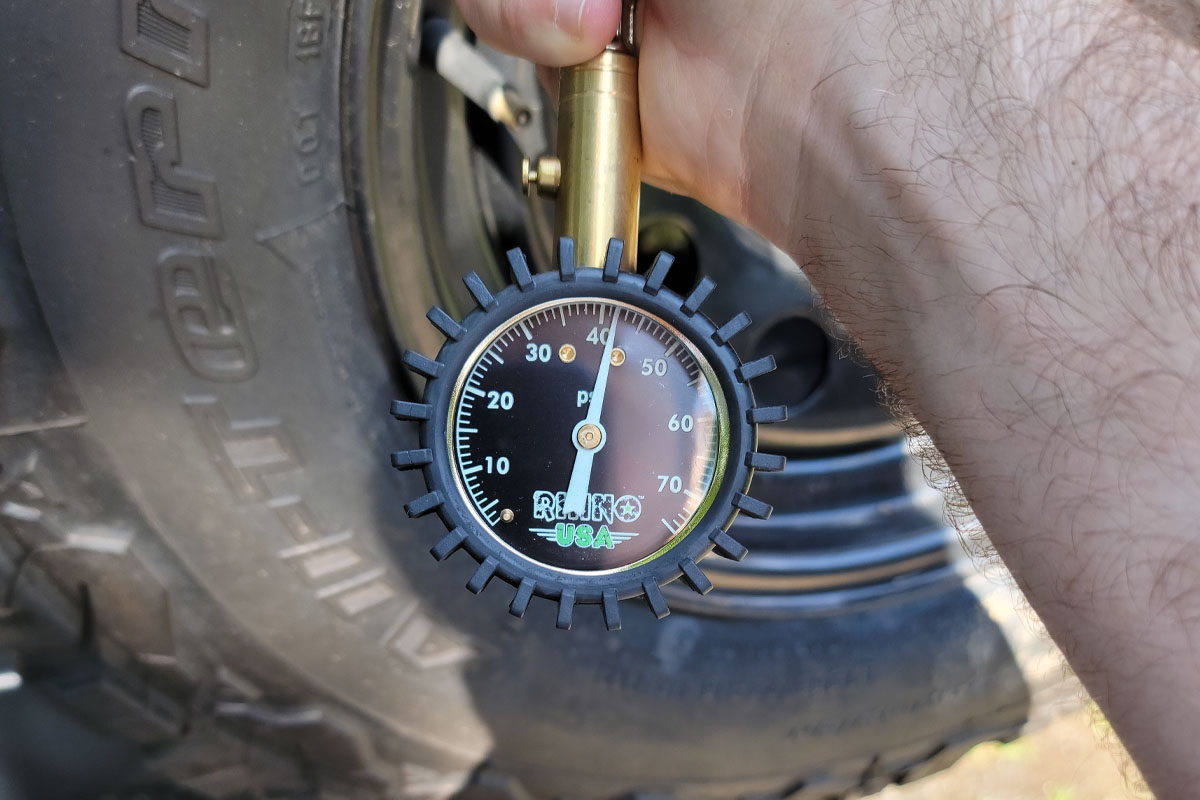
Types of Tire Pressure Gauges
Shoppers will find three standard types of pressure gauges: stick/pencil, analog/dial, and digital. The latter two can also attach to pneumatic hoses for inflating tires without detaching the gauge. But since they require you to have a pneumatic/compressor system at your disposal, they aren’t included in this article.
Stick/Pencil Gauge
The stick/pencil-type gauge is a traditional, old-school device that has been around for decades. It’s an analog tool made of a metal outer shell attached to a chuck and an inner measuring rod made of plastic or metal.
When applying pressure through the chuck valve, the inner rod extends according to the pounds per square inch (psi). Whatever length the rod extends to before it meets the outer shell will indicate the tire’s pressure. It’s basic and straightforward, which is why it has endured so long.
Analog/Dial Gauge
A dial or analog gauge has a clocklike face with a needle that points to the correct psi. Some are small and compact, and others have features like dual-scale dials or extension hoses. When attaching the gauge valve to the tire, the needle should rise quickly to the correct pressure and stay there until you hit the reset button (bleeder valve), which releases the captured air.
In general, these types of gauges are easier to read than stick versions. They are simple to use and reasonably compact but tend to be a little pricer than stick gauges.
Digital Gauge
Like a digital watch or calculator, a digital gauge has an LCD that relays the pressure reading. Digital gauges are usually the most accurate of all versions and can read pressure to ⅒ of a psi. The displays feature LED backlights, which come in handy for low-light situations.
The downside to digital models is that they tend to be a little more expensive and depend on batteries to operate. If you’re not someone who regularly checks the batteries in your electronic devices, this could be a problem. Low batteries also can cause faulty readings.
What to Consider When Choosing the Best Tire Pressure Gauge
There are several factors to keep in mind when choosing the best tire pressure gauge, including storage since it’s important to keep the gauge somewhere easily accessible. Price is another consideration. But the most vital considerations should focus on suitability, so make certain the pressure gauge has the right features for your specific needs and vehicle type. Someone commuting to work in a busy city daily has different needs than a retired driver who enjoys using his heavy pickup for off-road excursions.
Size and Weight
It’s generally better to keep your gauge somewhere other than your glove box since extreme temperatures—particularly the cold—can affect its function. However, if you plan to keep one there, a compact, light gauge is an ideal choice. Gauges can vary dramatically in size and weight, with some small models weighing just a couple of ounces and other models with additional bells and whistles weighing half a pound or more.
Vehicle Type
Depending on vehicle size and weight class, the valve on the tire might differ from vehicle to vehicle. Of the three major tire valve types, the most common are tubeless rubber snap-ins. These are for use on standard-size cars, minivans, and light-duty trailers. High-pressure tubeless snap-ins are for use on medium- to heavy-duty trucks. The third valve type is a high-pressure metal clamp-in valve used in vehicles that might exceed 130-mph speeds with tire pressure as high as 200 psi. Gauges that clamp onto the valve directly are recommended for this type of valve.
Check valve location on the tires and determine how difficult it is to reach the valve. You could need an extension hose if the valve is in an awkward space. Keep in mind that an extension hose requires two hands to operate.
Measurement Ranges
Measurement ranges among gauges can vary. Some stick versions only have a range of up to 50 psi, which is not enough to check the higher pressure spare that comes with most vehicles (typically 60 psi) but is sufficient for the installed tires. Digital gauges often have much wider ranges of 1 to 150 psi and can frequently give metric measurements as well, such as kPa, 1 kgf/cm2, and bars (see note below). These units all measure the same thing and simply depend on where you drive and where the vehicle and tires were manufactured.
Note: One psi equals 6.895 kilopascals (kPa), while1 kgf/cm² (kilogram-force per square centimeter) equals 98.0665 kPa, and 1 bar equals 100 kPa.
With standard-size vehicles like sedans, minivans, and light-duty trucks, a gauge that can read up to 60 psi will likely be sufficient. Having a broad-range gauge is good, but depending on how small the measurement etchings are, as with stick gauges, you might struggle to get an accurate reading.
Accuracy Grade
Most gauges have an accuracy of plus or minus 1 psi and are sufficient for most car drivers today. Only digital gauges can display greater accuracy to plus or minus 0.1 or 0.2 psi.
It’s important to check your new gauge for consistency and accuracy when you first unbox it. To do so, simply check the pressure on your tire 10 times in a row. If the reading varies significantly from test to test, instead of showing a constant reading all 10 times, return it and choose a different model.
Built-In Air Compressor/Inflator
When purchasing a gauge, a nice feature to have included is a built-in compressor/inflator. On average, while more expensive than a simple pressure gauge, it can be a big time-saver if you need to pump up an underinflated tire. Make sure you choose a compressor that reaches the required psi for your tires.
Since a compressor/inflator is much bigger and bulkier than a basic gauge, storage is a factor to keep in mind. Additional factors to consider include a power source for the unit and whether it will plug into the car’s 12-volt jack or features a cordless battery. Cordless versions are optimal if you have other tools that use the same batteries and consistently keep charged packs.
Usability
Quick, reliable readings are essential, so don’t overlook an easy-to-read display, especially in low-light conditions. Digital options include LED, light-up, or backlit displays that will work in the dark. Many analog dials also feature glow-in-the-dark displays that work almost as well as their digital counterpart, without the need for batteries.
Dropping a gauge too often can result in damage. Ergonomic grips can help reduce damage from dropping by enabling a firm hold, even while wearing winter gloves or with sweaty palms in the hot sun. Consider storing your tire pressure gauge in a protective case to help guard the device for the long haul.
Additional Features
The ability to determine whether your tires are properly inflated is a basic requirement for all gauges. However, many manufacturers also offer a few emergency tools to sweeten the deal. These can include 360-degree swivel chucks, lifetime warranties, different types of pressure measurements (psi and kPa, for example), and even auto-shutoff for some digital models.
Many gauges also feature built-in bleeder valves to let off excess pressure in case of overinflated tires, eliminating the need to detach the unit while you deflate it. Some devices are feature-rich, with built-in emergency tools, including flashlights, seat-belt cutters, safety hammers, and lights.
Our Top Picks
That’s a lot of information on the best tire inflators, and there might be a bit of pressure building when it comes to shopping. After extensive testing, we compiled the following list of products as a reference. Be sure to keep the top considerations in mind when comparing these products.
Best Overall
Rhino USA Heavy Duty Tire Pressure Gauge
Pros
- Glow-in-the-dark dial
- Hose and swiveling chuck for convenience
- Holds pressure reading on the gauge
- Solid brass
Cons
- Can require two hands for use
Product Specs
- Range: 0 to 75 psi
- Gauge style: Analog
- Size: Roughly 2 inches wide and 5 inches long, with hose
Rhino USA builds this analog gauge from solid, high-grade metals, and it doesn’t require batteries. The rubber, ergonomic grip gives adequate protection from damage and makes the gauge easier to handle during inclement weather, while its glow-in-the-dark dial allows users to see pressure readings even in low-light scenarios. Round it off with a 360-degree swivel chuck and a “no-leak” braided air hose, and there are plenty of valuable features in an analog package.
During testing, we really enjoyed the hose and swiveling chuck, as it was clear that this gauge would be easy to use in any situation. We also liked that this gauge locks the pressure reading in place until the user can check it. The solid brass construction was truly durable, and the braided hose was plenty flexible for our needs. If there is any complaint, it’s that you have to use two hands to take advantage of the hose. But since the pressure locks in place, it’s not a deal-breaker.
Best Bang for the Buck
Vondior Tire Pressure Gauge Heavy Duty
Pros
- Glow-in-the-dark dial is easy to read
- Holds pressure reading until released
- Swiveling chuck for awkward angles
Cons
- Falls might be this gauge’s downfall
Product Specs
- Range: 0 to 60 psi
- Gauge style: Analog
- Size: Roughly 2 inches wide by 5 inches long
The best tire pressure gauge should be straightforward and easy to use, and the Vondior Tire Pressure Gauge fits the bill. This heavy-duty, single-function tool features a glow-in-the-dark analog dial that helps the user see in low-light situations without having to rely on battery power. The protective rubber casing is ergonomic for comfort and conveniently offers some protection against drops. And at just 5 inches long, it fits easily in the palm of your hand.
Additional features include a bleeder valve for reducing overinflation and a swivel chuck for 360-degree connections to reach valves in various positions. For the price, it’s a solid deal that should work for most drivers’ needs.
At first, this was our favorite gauge in the bunch. It had a mechanical, trustworthy feel that we really enjoyed. The analog gauge was easy to use, and we liked that it held the pressure reading until released with the bleeder valve. And the swiveling chuck was super convenient. But after a series of drops, the glass on the dial broke and this gauge consistently read 10 psi lower than the others, so take measures to avoid dropping it.
Best LCD Screen
AstroAI Digital Tire Pressure Gauge
Pros
- Gauge is very easy to read
- Light-up chuck for checking pressures in the dark
- Compact size
Cons
- Least consistent in the group (though still consistently within 1 psi)
Product Specs
- Range: 4 to 150 psi
- Display style: Digital
- Size: Roughly 1.5 inches wide and 5 inches long
The AstroAI Digital Tire Pressure Gauge has a sleek design and simple, one-button digital operation. Along with a wide psi range, the gauge has an LCD-lit screen that works in various lighting scenarios. A handy lighted nozzle helps vehicle owners see the tire valve much easier, and the ergonomic grip fits snugly in hand. The digital gauge can switch between four different measurements (4-150 psi; 0-10 bar; 0-10 kgf/cm²; or 0-1000 kPa) and works with bicycle tires as well. This compact gauge is easy to store in a glove box.
Ultimately, this gauge was simple to use, and the display was incredibly crisp and easy to read. The light-up chuck is great for low-light conditions, and its compact size is ideal for small glove boxes. However, we found that this gauge was the least consistent overall but still provided readings within 1 psi of each other.
Best Stick Gauge
Milton (S-921) Single Chuck Tire Pressure Gauge
Pros
- Incredibly affordable
- Appeared to be very accurate
- Stick stays in place after removing for easier checking
Cons
- It needs to stay clean to remain accurate
Product Specs
- Range: 5 to 50 psi
- Display style: Stick
- Size: No larger than a marker
The Milton S-921 Single Chuck Tire Pressure Gauge offers simplicity in a sleek and useful tool. The compact design has been around for decades. Although it doesn’t have any fancy features, the gauge works well in cold weather and is nearly foolproof to use. This stick-type gauge costs less than other tire gauge types, and it provides measurements in psi and kPa. The display doesn’t glow in the dark, but this stick gauge is so easy to use that it takes little time to get a reading. It also takes up little space in your car, measuring only 8.1 by 1.2 by 1.1 inches.
For the price, it’s hard to beat a reliable stick gauge like this one. We found that it was consistent and accurate, and unlike some other stick gauges that retract the stick after releasing the pressure, this one doesn’t. This allowed us to check the reading without bending over or kneeling. The only issue we found is that you’ll want to keep the stick as clean as possible, as gunk or dirt can affect the reading.
Best With Tire Inflator
Makita DMP180ZX 18V LXT Lithium-Ion Cordless Inflator
Pros
- Added benefit of being able to inflate the tire
- Built-in worklight
- Programmable maximum pressure
- Comes with inflation accessories
Cons
- Much too large for a glove box
- Requires a battery, even for just checking the pressure
Product Specs
- Range: 0 to 120 psi
- Display style: Digital
- Size: Roughly 9 inches long, 2.25 inches wide, and 6.5 inches tall (with battery)
With its lightweight, compact barbell design, the Makita DMP180ZX 18V LXT Lithium-Ion Inflator is handy to cart around. The pressure gauge display is backlit and conveniently shuts off as soon as it reaches the preset desired pressure. A built-in LED light on the front of the inflator illuminates the work area. Furthermore, those who own other Makita tools can use the 18V batteries they already own for the inflator without purchasing a separate one. After measuring pressure, users can add air to a tire quickly with this portable inflator.
Testing this compressor against the other models on the list almost felt unfair, as it’s capable of so much more. It has a built-in worklight, it can obviously inflate a tire (and it has a programmable max pressure), and it comes with accessories like a sports ball needle and inflatable toy nozzle. It’s very easy to use, and the gauge is reasonably accurate within 0.5 psi. But, there are downsides: The digital gauge requires a charged battery no matter what, and it’s much too large for a glove box.
Best Compact
Slime Digital Sport Tire Pressure Gauge
Pros
- Excellent digital gauge
- Tiny enough for any built-in compartment
- Light-up chuck for low-light pressure checks
Cons
- It might be too small for large or gloved hands
Product Specs
- Range: 5 to 150 psi
- Display style: Digital
- Size: 4.5 inches long by 1.75 inches wide
Anyone hunting for a tire pressure gauge that can be stored almost anywhere should check out Slime’s Digital Sport Tire Pressure Gauge. This digital model features a pressure range between 5 and 150 psi and a light-up chuck for low-light pressure checks. It also provides readings in psi, kPa, and bar.
Comparing this tire pressure gauge to the other models on the list, it was easy to tell just how much more compact it is. It’s small enough to fit almost anywhere, which is great for anyone with an older or classic vehicle without a lot of storage. We also enjoyed the digital dial, as it was very crisp with plenty of contrast. The only real concern we noticed is that it might actually be too small for gloved or larger hands.
Our Verdict
For its usability, affordability, and durability, the Rhino USA Heavy Duty Tire Pressure Gauge reigned supreme. But for those who might need a few more features, the Makita DMP180ZX Inflator has what it takes to not only check the pressure but also boost it when necessary.
How We Tested the Best Tire Pressure Gauges
In order to provide some honest feedback about these tire pressure gauges, we tested each one several times. The tests included some environmental conditions and some shock testing, which most passed quite easily. And since the old off-roader we used doesn’t have built-in tire pressure monitoring, it was the perfect test subject.
First, we tested each gauge at room temperature. We brought each gauge to a spare tire and checked the readings 10 times. Obviously, after checking 10 times, the pressure would drop, but we wanted to check for consistency. Then, we put all of the gauges in the refrigerator for an hour to simulate how they might work in cold temperatures. Finally, we left them out in the hot afternoon sun and repeated the test, simulating how they might work if left in a hot car.
The toughest test was the waist-high drop. We held each of these tire pressure gauges (except for the Makita) at waist height and dropped them five times. After dropping them five times, we took readings from the tire. Almost all did well, except for the Vondior, which we describe above.
Tips for Using a Tire Pressure Gauge
Start with finding out your vehicle’s optimal psi by checking the driver’s side door for a sticker that lists the information. Don’t go by the recommendation on the tire if you can avoid it. Next, remove the caps from the valve stems on your tires, and press the gauge nozzle tightly to the tire valve’s tip. Some air escaping the tire is normal, but it shouldn’t be excessive. There should only be a brief second or two of hissing. Read the gauge according to your individual tool’s operating instructions, then switch it off or reset it when finished. Inflate the tire or release some air according to what you find. After inflation, replace the caps on the tire valves.
- Store the gauge in its proper protective case, since dirt or debris in the nozzle can damage the seal.
- Remember tire pressure drops as the temperature gets colder, so an average pressure of 30 psi in warm weather will read at 25 psi when it’s near freezing outside.
- Not all tires on your vehicle will necessarily have the same pressure needs.
- Don’t forget to check the spare.
FAQs
When considering a new device or wondering if you’ve got the best tire pressure gauge for your vehicle, look over the answers to these commonly asked questions below.
Q. Are tire pressure gauges accurate?
Most analog gauges are accurate to plus or minus 1 psi, and digital ones are plus or minus 0.01 psi. Check a new gauge for consistency.
Q. How do I use a tire pressure gauge?
Reset the gauge to zero. Press the nozzle/chuck firmly against the tire valve and hold for a second or two, and you should see the reading right away.
Q. How often should I check my tire pressure?
On average, your tires lose about 1 psi per month. As a rule, it’s a good idea to check the pressure at least once a month, especially during the fall and winter months. And remember to check your spare.
Q. How do I know if my tires are properly inflated?
Check the inside of your driver’s door for a sticker that should recommend the optimal pressure for each of the tires.


